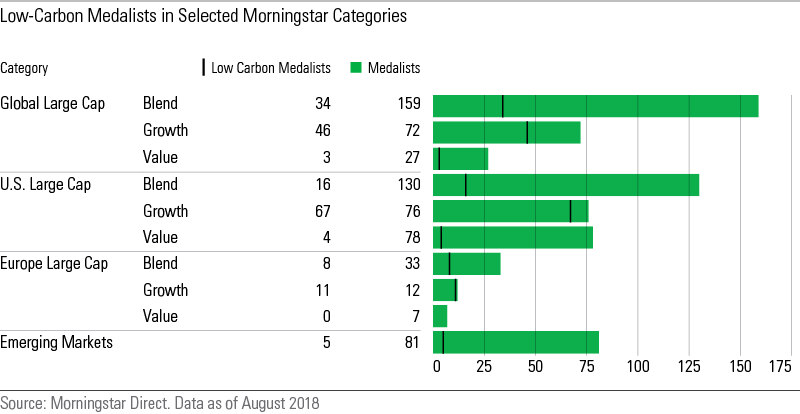Investing Trends
How Much Carbon Risk Do Morningstar Medalists Carry?
What we found when we analyzed the carbon risk in our medalists funds

Investors are increasingly aware that climate change poses risks to their investment portfolios and are looking to manage these risks. To this end, Morningstar recently launched a series of carbon risk metrics. We also introduced the Morningstar® Low Carbon Designation™ to help investors identify those funds that are in general alignment with the transition away from a fossil-fuel intensive economy to a low-carbon economy.
Analyzing carbon risk in Morningstar Medalists
Investors concerned about transition risk can incorporate the Low Carbon designation into their selection process, in combination with the Morningstar Analyst Rating™ of Gold, Silver and Bronze.
We did just that in a recent analysis. We found that of all 3,801 medalist funds—funds that Morningstar analysts believe will outperform their peers going forward—only 412, or 11%, have received the Low Carbon designation. We also found that the choices are not spread evenly across investment categories because carbon risk is related to style and, especially, sector exposures.

Carbon risk in growth funds
Looking at 10 diversified investment categories (above), we found that close to two thirds of the low-carbon Morningstar Medalists are growth funds. Why? Because growth funds tend not to invest in companies in the three sectors with the most carbon risk (energy, utilities, and materials), while having significant investments in technology companies, which carry very little carbon risk. Among the U.S. and Europe large-growth funds, it’s very easy to find a good low-carbon fund as 88% and 92% of the medalists in these categories, respectively, receive the Low Carbon designation.
Carbon risk in value funds
It’s significantly harder, however, to find a good low-carbon fund on the value side, especially in the Europe large-value category where no Morningstar Medalists receive the Low Carbon designation. In the U.S. and global large-value categories, only 11% and 5% of the medalists, respectively, receive the Low Carbon designation.
Europe large-value funds, on average, devote nearly 22% of assets to companies in the higher-carbon-risk energy, utilities, and materials sectors and only less than 5% to tech companies. U.S. and global large-value funds, on average, are more balanced in terms of how much they allocate to higher-carbon-risk and lower-carbon-risk sectors.
Emerging markets and carbon risk
Fewer emerging-markets funds (6%) receive the Low Carbon designation. Emerging-markets managers generally must choose among companies with higher carbon risk compared with developed-markets managers. In the automobile industry, for example, emerging-markets firms have an average Morningstar® Portfolio Carbon Risk Score™ of 41.2, in the High risk range, while developed-markets firms have a much lower average score of 26.3, in the Medium risk range.
When to use the Carbon Risk Score
To find additional lower-carbon options in the large-value and emerging-markets categories, investors should use the Carbon Risk Score rather than the Low Carbon designation and search for funds with scores in the category’s lowest quartile. That’s a weaker screen than the Low Carbon designation, because it doesn’t include an explicit fossil-fuel exposure component, but the Carbon Risk Score can be compared with other funds.
This blog post is adapted from research that was originally published in Research Portal in Morningstar Direct™. If you’re a user, you have access. If not, take a free trial